
The question sometimes comes up: “Where should I start with Flannery O’Connor?”
Perhaps the person posing the question has never read O’Connor at all. Or he might have encountered one of her widely anthologized stories in high school or college—probably “A Good Man is Hard to Find” or “Revelation”—and wanted to revisit her work.
That’s a good and important question, because if you start reading O’Connor—who died on August 3, 1964—in the wrong place or the wrong frame of mind, you won’t get her now or maybe even ever. There are lots of people who have read O’Connor and just don’t like her writing, and don’t see what in the world the rest of us are raving about. Which is fine, because, you know—to each his own.
And not to be too didactic about the whole thing—if you’re serious about trying to read O’Connor intelligently, I really think you need to have, besides the fiction (and I’d start with, perhaps, “A Good Man is Hard to Find,” “Revelation,” and “A Temple of the Holy Ghost), two other works at your side: Mystery and Manners, a collection of her thoughts on writing and faith, and her letters, collected in The Habit of Being.
Now, there is always the danger of over-analysis coming between the reader and author, a danger of which O’Connor was keenly aware.
In a letter of March 28, 1961, to a professor of English who shared with O’Connor his students’ interpretation of “A Good Man is Hard to Find,” she began: “The interpretation of your ninety students and three teachers is fantastic and about as far from my intentions as it could get to be.” She finishes her note off with: “Too much interpretation is certainly worse than too little, and where feeling for a story is absent, theory will not supply it. My tone is not meant to be obnoxious. I am in a state of shock.”
But the idea of reading a bit of Mystery and Manners—even what might be available here and there online—and having the letters close by is not for the purpose of “correct” interpretation, but merely to understand what O’Connor herself was trying to do. I can’t tell you how many people I have met who have said to me either that after reading a couple of O’Connor stories they were shocked to find out she was Catholic or that they knew she was Catholic and they knew her faith was important to her—but they just couldn’t see it. They saw blood and rudeness and ignorance, certainly—but they just couldn’t see the “Catholic” part.
Thanks to documentarian Bridget Kurt, we now have another tool for introducing the world and work of Flannery O’Connor to the curious and confused: a one-hour documentary called Uncommon Grace.
Using photographs and the testimony of eminent O’Connor scholars like William Sessions and Brad Gooch, Kurt tells the story of O’Connor’s life from her birth in Savannah in 1925 to her death just 39 years later a couple of hundred miles away in Milledgeville, Georgia. Along the way Kurt also intelligently unpacks the story of the bigger story O’Connor was trying to tell: the true story of human beings, created for one thing, but hell-bent on the road for another, unless they can open up to grace, grace which enters in the most unexpected ways.
Mary Flannery O’Connor was an only child from a Catholic family, born in Savannah. The childhood home, now renovated and open for tours, is located across the street from St. John the Baptist Cathedral on one of those iconic Savannah squares. Uncommon Grace does a lovely job with O’Connor’s childhood, letting us peak into the world of a singular child who wrote as a teenager, “I am only 14 years old, but I feel I need to bring literature into being.” Singular, indeed.
Uncommon Grace takes us with the O’Connors as they move from Savannah, first to Atlanta for a time (which Flannery hated) and then to her mother’s hometown of Milledgeville, a bit northeast of Macon. In her teens, Flannery flourished both as a writer for her school newspaper and as an artist. She was a witty cartoonist, and in fact, had thought for a time—even through college at the Georgia State College for Women—that would be her career path.
But writing it was to be, and writing took her, after graduation, up north to the renowned Iowa Writer’s Workshop. The documentary offers a good look into O’Connor’s participation in this lively period of mid-century American letters and the transitions in her life over the next few years: her deepening commitment to fiction, her self-understanding, her move from Iowa to New York, and, tragically, her health problems.
For O’Connor, like her father, suffered from lupus. The diagnosis was initially kept from Flannery herself, her mother being the one to receive the news after Flannery had an episode in New York that required her to return to Georgia for help.
And it was in Georgia that lupus forced her to stay for the rest of her life. She lived with her mother on their working dairy farm called Andalusia, went to daily Mass, wrote for two hours a day, read, corresponded, interacted with the locals, and ended her day with a dose of the Summa.
When she died in 1964, she left behind dozens of short stories and two novels which are brilliantly observant of both the world around her and human behavior, works that are both funny and tragic, shocking but yet deeply recognizable.
But how? How is it that stories about shyster Bible salesmen, unbelieving preachers, murderers, farmers, racists, and arrogant pseudo-intellectuals—most of whom find themselves at the wrong end of a gun or bull or weaponized textbook at one time or another—can be “spiritual”? Where’s my gauzy cover art and happy ending?
Well, if that’s our notion of “spiritual reading”—either fictional or non-fictional—no, we’re not going to “get” Flannery O’Connor. O’Connor looked at the world and saw a hard place—not because God wanted it so, but because we made it so. Moreover, she saw a loud place, deaf and blind and deeply resistant to grace—grace that she knew and trusted was still being offered.
How do you get the shysters, the unbelievers, the intolerant, and the prideful—namely, all of us—to see? You must, as she said of her own writing, shout. You must exaggerate.
Uncommon Grace helps the viewer understand this basic key to O’Connor’s work. The film also does an excellent job helping us see something so important, something that is very clear in O’Connor’s letters: how she suffered, but did so with grace and humor.
O’Connor’s work is important. Her life and spiritual witness is important as well.
For Flannery O’Connor, like all of us, had plans. Unlike many of us, perhaps, she also had a clear sense of her own gifts. As a very young woman, she set out to follow that path. She had fantastic opportunities at Iowa, made great connections and seemed to be on the road to success at a very young age. Wise Blood was accepted for publication when she was in her early 20s. She was in New York. She was starting to run in invigorating literary circles.
And then she got sick.
And she had to go back to her mother’s farm in Milledgeville, Georgia.
O’Connor’s story is a helpful and necessary corrective, it seems to me, of the current spiritual environment which privileges choice and health and seeks to baptize secular notions of success, achievement, and even beauty. What is missing from all of that is a cheerful acceptance of limitations and a faith that even within those limitations—only within those limitations—we are called to serve God.
It’s because of that part of Flannery O’Connor’s story—and not just the story of her genius and art—that Uncommon Grace would be an excellent choice to show, not only to interested adults, but also high school students. Many will be reading at least one O’Connor story as part of their curriculum, and Uncommon Grace is an excellent basic introduction to the themes in her work. But adolescents would also benefit from this brief encounter with Flannery O’Connor as a person much like themselves—young, hopeful for her future with gifts to share with the world—and from considering her faith-filled response when life, as it tends to do, doesn’t go as planned.
(Note: As I watched the documentary, I noted how few of O’Connor’s actual words were used in the narration. I thought the piece would be stronger if her letters, at least, were quoted once in a while, and I wondered if there were copyright issues that prevented it. An interview with Bridget Kurt here indicates that this was, indeed the case.)
If you value the news and views Catholic World Report provides, please consider donating to support our efforts. Your contribution will help us continue to make CWR available to all readers worldwide for free, without a subscription. Thank you for your generosity!
Click here for more information on donating to CWR. Click here to sign up for our newsletter.







Do you know if this airing on TV any time soon? I think it is available for purchase. Is that true? I would like to see it.
It was on many PBS stations this past spring. You can contact your local PBS station and ask them to re-broadcast the film via the World Channel. It is also available on Amazon for sale. You can also ask your local library to purchase a copy of the film via Amazon.https://www.amazon.com/Uncommon-Grace-Life-Flannery-OConnor/dp/B018HEW22Y
Catholic friendly Baptist Professor Ralph Woods has a terrific talk on chastity and Temple of the Holy Ghost.
https://www.youtube.com/watch?v=AaZf7mhfhzo
Many people are unaware that Mary Flannery was a cartoonist.
https://www.brainpickings.org/2013/12/12/flannery-oconnor-cartoons/
Movie trailer.
https://www.youtube.com/watch?v=XqcSWztbnog
She was known to have instant rapport with students — “they all loved her” — with her riotous sense of humor.
Her writing called Gothic transcends the literary genre. The reason is the tales are so bizarre a negation of goodness, sanity that the opposite reaction comes home. Hazel Motes founds “The Church Without Christ, where the blind don’t see and the lame don’t walk and what’s dead stays that way. Later in his crusade he refines the message by starting with, ‘Listen you people. I’m going to preach there was no Fall because there was nothing to fall from and no Redemption because there was no Fall and no Judgement because there wasn’t the first two. Nothing matters but that Jesus was a liar'” (Religious Vision and Free Will in Flannery O’Connor’s Novel Wise Blood, Stephen Sparrow). The characters seems comical. Hazel Motes absurd. Yet Sparrow notes, “He arrives home [after military discharge] to find Eastrod deserted, a home which no longer exists both literally and figuratively and symbolising a society now broken and uncaring. Ever since his unhappy youth he had been thinking that Jesus must be the problem and that the way to avoid Jesus was to avoid sin. Reacting against the guide that resides in each of us, he now sets out on a crusade against God”. There is an analogy in this to the Catholic Church 2017. An angry dismissal of Apostolic Tradition, revised Gospel eliminating the Logos. The vitriol inflicted on those who seek clarity, who object.
The film is available on Amazon. https://www.amazon.com/Uncommon-Grace-Life-Flannery-OConnor/dp/B018HEW22Y The website for the film is http://www.beataproductions.com
Here is the link to the first 5 minutes of the film:https://www.youtube.com/watch?v=UjHvo9JhQE4
The razor sharp insight of this extraordinary author would serve as the biting corrective for what the Church endures at the hands of its own in the Bergoglian captivity. Would that she were still with us.
Who will stand in her place?
It is often said that Catholicism is not for the faint of heart.
But neither is living.
I don’t know of a single writer who embodies those two observations better than O’Connor does.
Thank you, Amy, for keeping her memory alive!